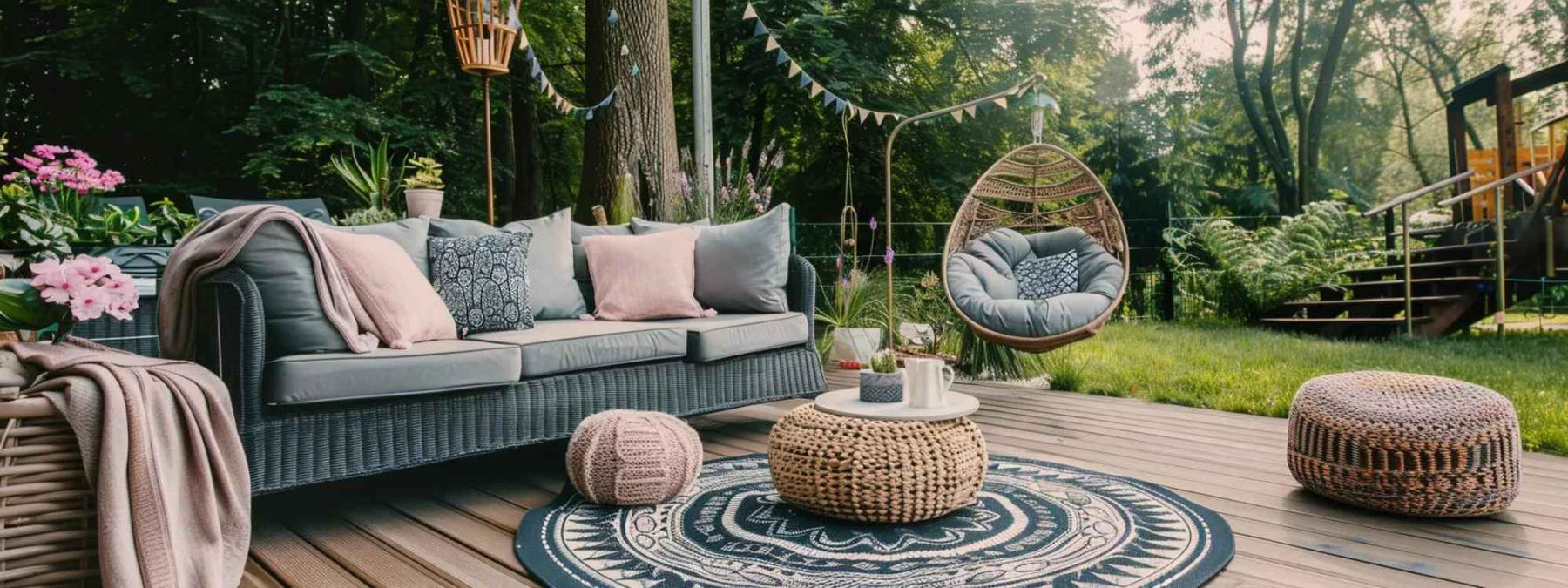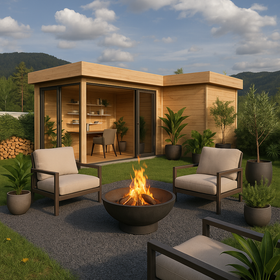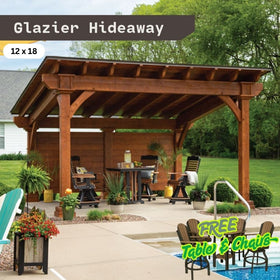512-777-0154

Choosing the Right Furniture for Your Outdoor Space
Choosing outdoor furniture seems easy until you start shopping. Suddenly, you're stuck scrolling endlessly, unsure if anything matches your space or your style. Maybe you’ve already bought a set you thought was perfect, only to watch it fade after the first heavy rain. Or perhaps you’ve ended up with chairs so uncomfortable, your guests prefer standing.
Picking the right outdoor furniture isn’t just about aesthetics. It's about creating a space that genuinely fits how you live—whether that means cozy dinners under the stars or relaxed afternoons spent reading in the shade.
But, how to choose outdoor furniture that complements your space, survives the elements, and, importantly, feels good to use?
By the end, you’ll have clear steps and practical tips that take the stress out of shopping and help you build an outdoor space you'll use.
What Do You Need from Your Outdoor Furniture?
Is it your quiet corner to sip coffee in the morning? A place to host dinner parties? Or maybe it's where the kids run around while you try to relax for five minutes.
The purpose of your space matters. A lot.
If you love entertaining, a roomy outdoor dining table like LuxCraft Luminary Furniture Set and stackable chairs might make sense. Prefer lazy afternoons reading? Then you’re probably after a deep-seated lounger and a LuxCraft Deluxe End Table 28" for your drink.
Measuring your space saves you from buying a six-piece set that ends up looking like a furniture traffic jam. Think about how much walking room you want. And don’t forget about door clearances or tight corners.
Then consider the weather. Are you dealing with blazing sun, heavy rain, or high winds? This helps you narrow down materials that will last.
Lastly, think about your habits. If you hate maintenance, skip the teak and go with powder-coated aluminum. If you want to rearrange often, avoid heavy pieces you’ll dread moving.
Once you know how you plan to use your outdoor living space, picking the right furniture becomes way easier.
Choosing the Right Material
Picking outdoor furniture isn’t just about color or style. The material matters just as much. Maybe more.
Why? Because the wrong choice can leave you with faded cushions, rust stains, or a warped bench after one rainy season.
1. Wood: Classic Charm or High Maintenance?
Wood looks great. It has that warm, timeless feel that works on almost any patio, garden, or outdoor kitchen. But it doesn’t come without effort.
Hardwoods like teak and eucalyptus are better at handling sun and rain. Still, they need some care. Think of occasional oiling and storing them during harsh winters.
If that already sounds like too much, look for wood that's pre-treated or sealed. And consider covers to extend its life. It’s a bit of work, but the payoff is furniture that looks better with age.
2. Metal: Durable but Comfortable?
Aluminum and steel can take a beating from the weather. They're sturdy, often sleek, and won’t blow away with the first gust of wind.
But here’s the thing—metal seats aren’t exactly lounging material. Especially in the sun.
Add LuxCraft 5' Seat Cushions. Lots of them. Or place pieces in shaded spots to keep them cool. Powder-coated options are best since they resist rust better. And yes, they’re usually lighter than they look.
3. Plastic and Resin: Practical or Cheap Looking?
You’ve probably seen the flimsy stuff. But not all plastic is created equal.
High-quality resin furniture can hold up well. It’s light, affordable, and surprisingly durable if you pick UV-resistant pieces.
It won’t give you the charm of wood or the strength of metal—but it’s easy to clean, easy to move, and hard to ruin.
Comfort vs. Style
Outdoor furniture sets should look good—but not at the cost of your back.
A sleek chair might catch your eye, but if it feels like sitting on a rock, it’s not doing you any favors. On the flip side, that ultra-cozy LuxCraft Lounge Chair might feel amazing, but clash with everything else on your patio.
The goal? Balance.
Start with the basics: LuxCraft Lounge Cushion helps more than you think. Add them to benches, chairs, and loungers. Removable covers make cleaning easier, and waterproof options save you from surprises after a rain.
Ergonomics matter too. Low, deep seats are great for lounging. Higher, firmer ones work better for meals or conversation. Think about how you’ll use the furniture most days.
Modular pieces are a solid choice if your setup needs to flex. You can rearrange as needed, and they often blend comfort with clean design.
One common mistake? Going all-in on looks and forgetting the feel. Or buying something ultra-comfy that turns into an eyesore over time.
Test pieces in person when possible. If you're shopping online, dig into reviews that mention comfort, not just appearance.
Size Matters (and Bigger Isn’t Always Better)
Before you fall in love with that oversized sectional, grab a tape measure.
Start by measuring your patio, balcony, or backyard area. Note the usable space—not just the total square footage. Pathways, doors, grills, and garden beds all count.
Then think about how you’ll move around the furniture. Leave at least 2–3 feet of clearance so you’re not side-stepping chairs or squeezing through tight spots.
When it comes to furniture, scale matters. A huge sofa in a small space can overwhelm it. Tiny chairs on a big deck? They get lost. Choose pieces that feel balanced, not crammed or floating.
Pro tip: tape out dimensions on the ground using painter’s tape. It’s a quick way to visualize fit before buying.
Weather-Proofing Your Investment: What Works?
Outdoor furniture has one job—survive the elements. But not all materials handle weather equally.

Live somewhere hot and sunny? Look for UV-resistant finishes. Wood tends to fade, so sealed hardwoods like teak or eucalyptus hold up better. Powder-coated metal resists rust. Resin? Good for rain and humidity, as long as it’s not the cheap, brittle kind.
Cushions matter too. Opt for quick-dry foam and covers made from solution-dyed acrylics—they resist mildew and fading better than standard fabrics.
When storms roll in, covers are your best friend. They keep out rain, dirt, and sun damage. Or, if you’ve got the space, store cushions and lighter pieces in a shed or storage bench when not in use.
Also, furniture that’s designed specifically for outdoor use will hold up better, period. Indoor pieces that look “outdoor-ish” usually don’t last.
Investing in the right materials up front saves you from replacing them every season.
Easy Maintenance: Enjoy More, Clean Less
Low-maintenance furniture doesn’t mean low-quality. It means smart choices.
Powder-coated aluminum, resin wicker, and treated wood are all good bets. They don’t need constant scrubbing or re-sealing. Stick with smooth surfaces that don’t trap dirt or pollen.
Cushions? Removable, washable covers make life easier. And choosing neutral colors helps hide dust between cleanings.
For a quick clean, a soft-bristle brush and mild soap work wonders. Hose it off, let it air dry, done. Skip harsh chemicals—they often do more harm than good.
Also, placing furniture under a covered area—or just using a simple cover—dramatically cuts down on grime and sun damage.
The less time you spend maintaining your furniture, the more time you get to use it.
Ready to Turn That Outdoor Space Into Your Favorite Room?
Choosing the right outdoor furniture doesn’t have to feel like solving a puzzle.
Think about how you’ll use the space—dining, relaxing, hosting. Pick materials that can handle your local weather without demanding constant upkeep. Look for comfort, but don’t ignore size or layout. And if something looks good but isn’t practical, it’s probably not worth it.
The best setup isn’t the trendiest or the most expensive. It’s the one that fits your lifestyle, your space, and your habits.
Take your time. Plan around how you live—not how you think it should look.
And if you're looking for more smart tips on outdoor living, feel free to explore our other guides. There’s more where this came from.








